Training exercises
51 of 51 exercises
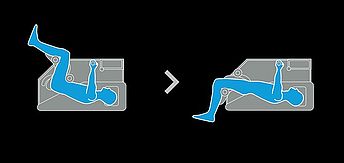
A1
Hip extension
A1
Hip extension
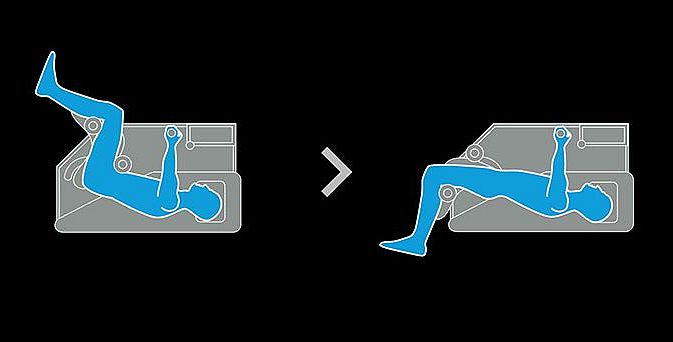
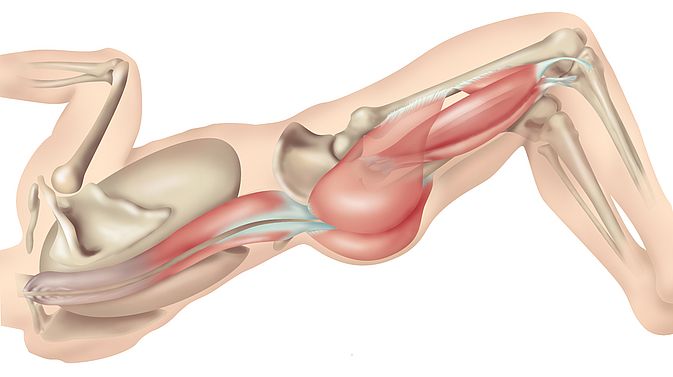
Usage
Exercise
One of the main functions of the large gluteal muscle is to straighten the trunk from a bent position.
With the hip extension exercise, you can strengthen the large gluteal muscle, the two-headed biceps femoris, the erector spinae, the semitendinosus muscle and the semimembranosus muscle. In this exercise, you stretch the leg through the hip joint as far back as possible.
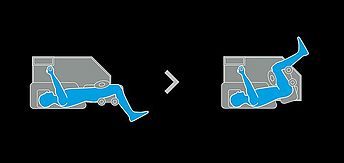
A2
Torso flexion
A2
Torso flexion
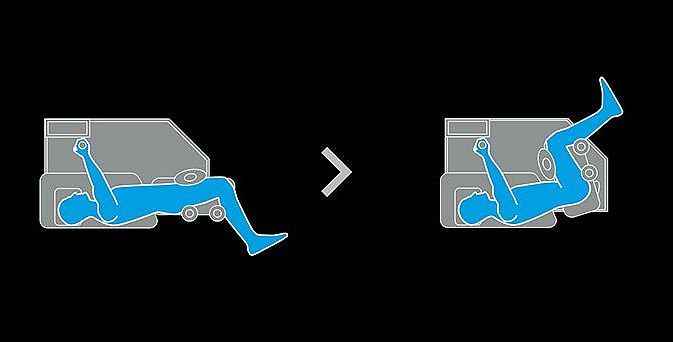
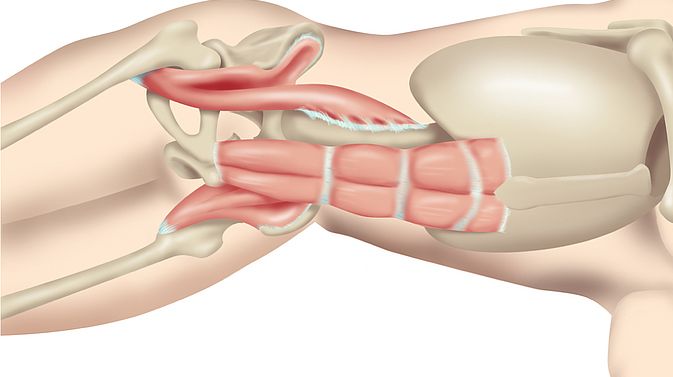
Usage
Exercise
The straight muscles of the abdomen stabilise the position of the pelvis and can reduce strain on the lumbar discs.
By bending the hip joint, you can train the iliopsoas muscle and the rectus abdominis muscle. This is done by bending the leg through your hip joint by drawing your knee towards your chest.
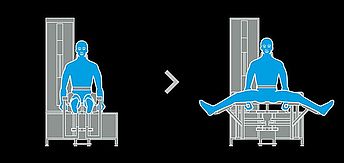
A3
Hip abduction
A3
Hip abduction
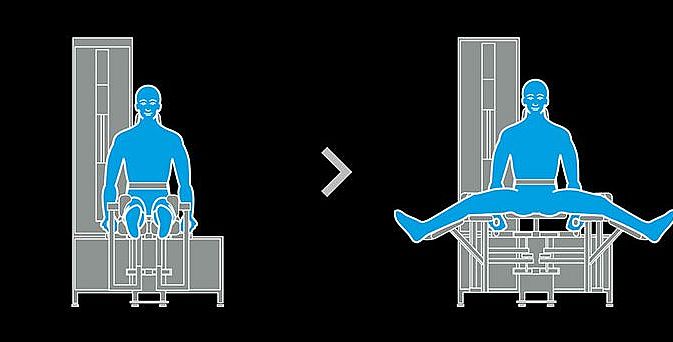
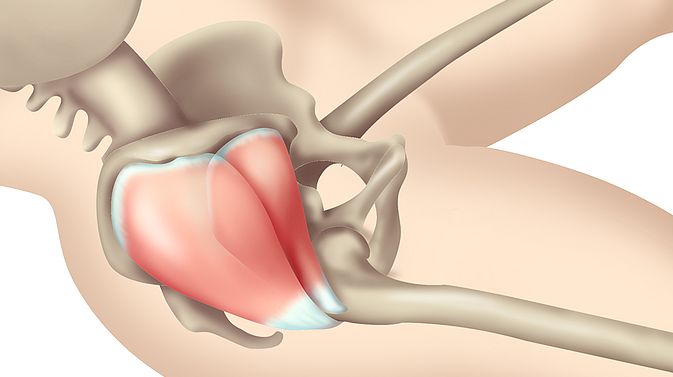
Usage
Exercise
One function of the gluteus medius is to prevent the pelvis from tipping towards the non-load-bearing leg.
Our machine for abducting the hip joint trains the gluteus minimus and the gluteus medius. In this exercise you push the upper thigh to the side as far as possible.
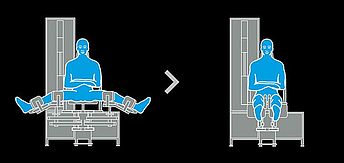
A4
Hip adduction
A4
Hip adduction
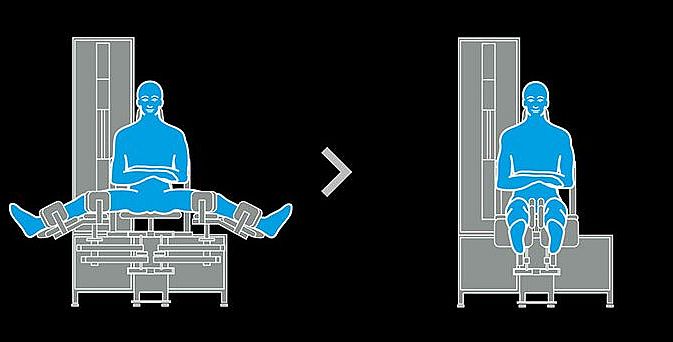
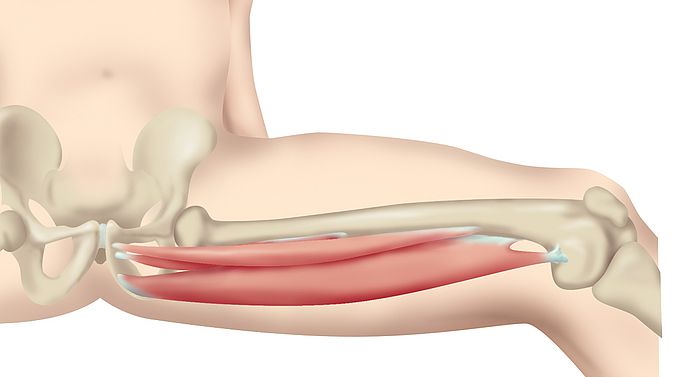
Usage
Exercise
One function of the adductor muscles is to prevent the legs from being pushed apart by the weight of the body while in an abducted state.
Using the A4 exercise for adduction of the hip joint, you can train your adductor muscles. In this exercise, you push the upper thigh as far as it will go against the leg pad.
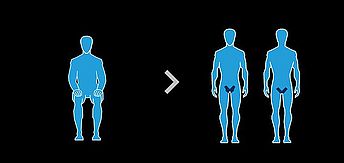
A5
Pelvic floor contraction
A5
Pelvic floor contraction
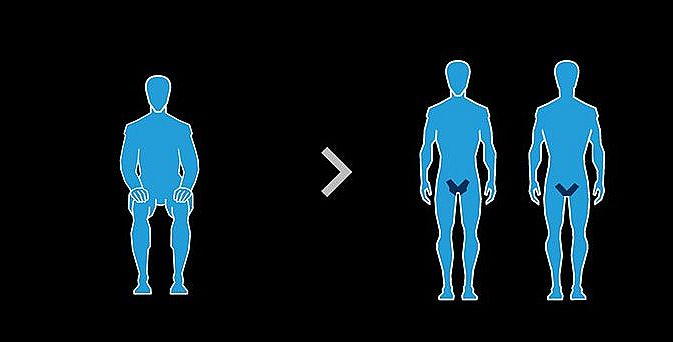
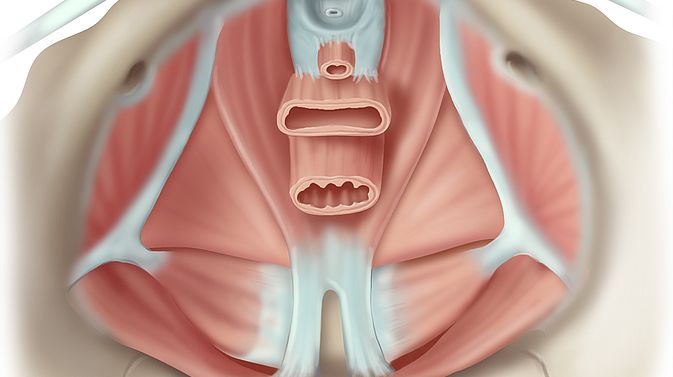
Usage
Exercise
Both men and women can train the pelvic floor muscles to stabilise the torso, ensure continence and reduce the risk of a prolapse.
The machine for contracting the pelvic floor helps to train the ischiocavernosus, the lower perineum and the levator ani muscles. In this exercise, you sit on a sensor tube that is connected to a computer. Your pelvic floor contractions are displayed on the screen.
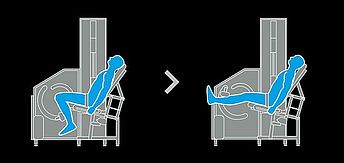
B1
Leg extension
B1
Leg extension
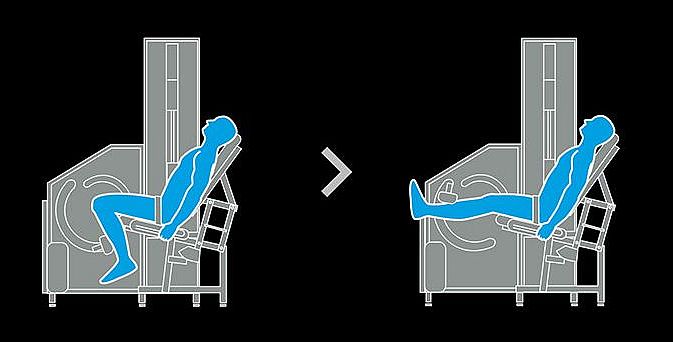
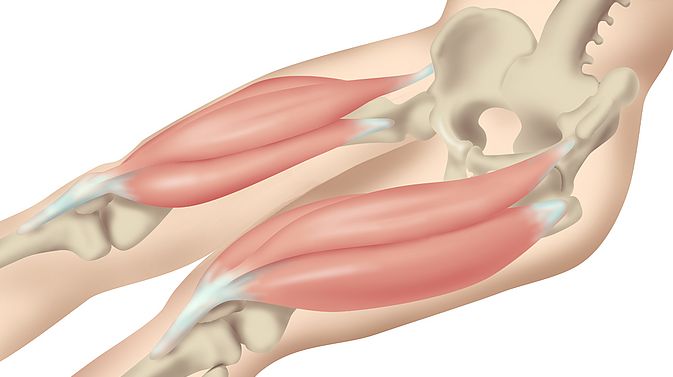
Usage
Exercise
The quadricep muscles contribute to supporting the knee joint.
When stretching the knee joint, you also train the quadriceps. In this exercise, you stretch the leg until it is fully extended.
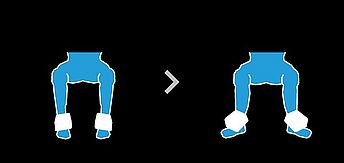
B3
Foot pronation
B3
Foot pronation
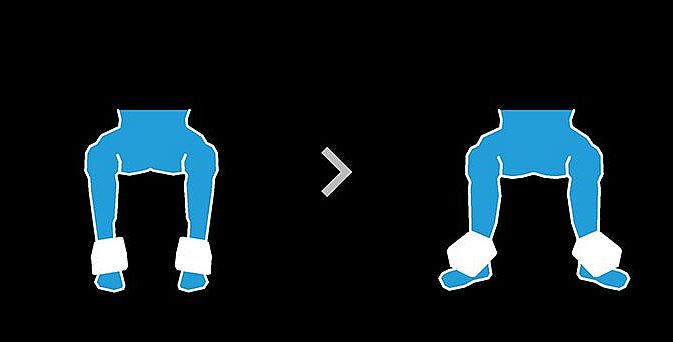
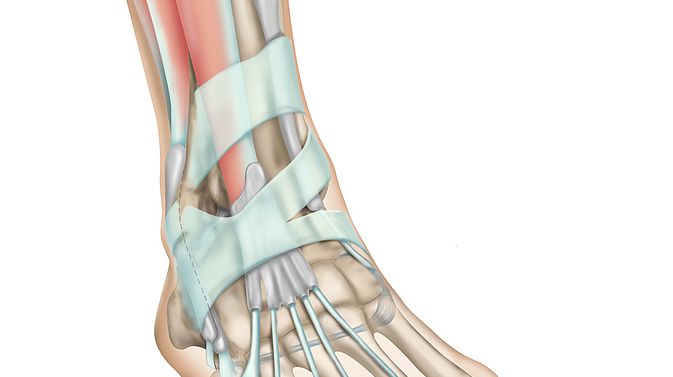
Usage
Exercise
Pronation and supination of the ankle helps to prevent it from folding to the side.
Exercising the pronation of the ankle trains the peroneus, the tibialis anterior and extensor digitorum longus muscles. In this exercise, you turn the foot slowly outwards.
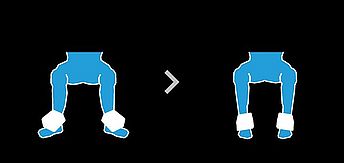
B4
Foot supination
B4
Foot supination
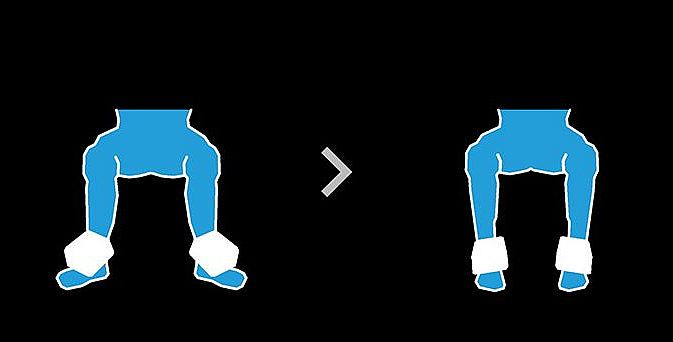
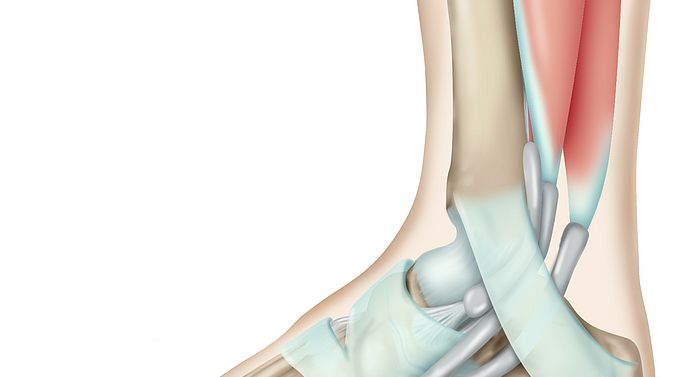
Usage
Exercise
The B4 exercise helps to stabilise the ankle and prevent injury.
Exercising the supination of the lower ankle trains the tibialis posterior, flexor hallucis longus and flexor digitorum longus muscles. In this exercise, you turn the foot slowly inwards.
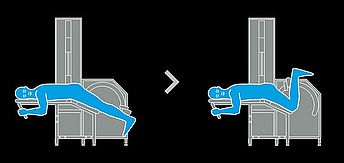
B5
Prone leg curl
B5
Prone leg curl
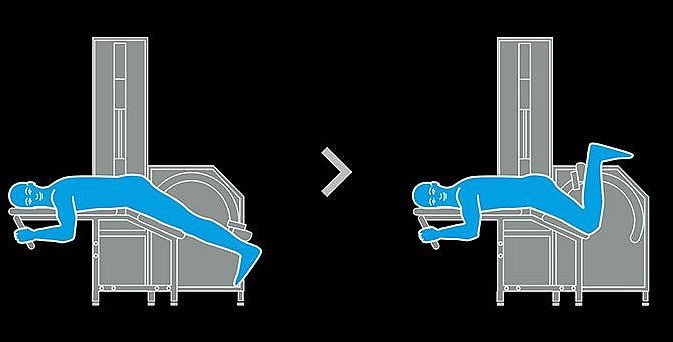
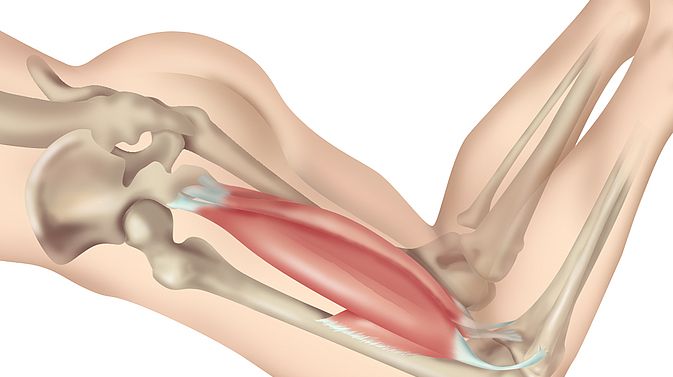
Usage
Exercise
Training the hamstring muscles helps maintain the pelvis in the correct position.
When bending the knee joint in the prone position, you train the two-headed biceps femoris, the semitendinosus and semimembranosus muscles. In this exercise, you try to bend your leg at the knee joint and move your heels towards your buttocks.
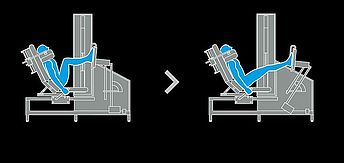
B6
Leg press
B6
Leg press

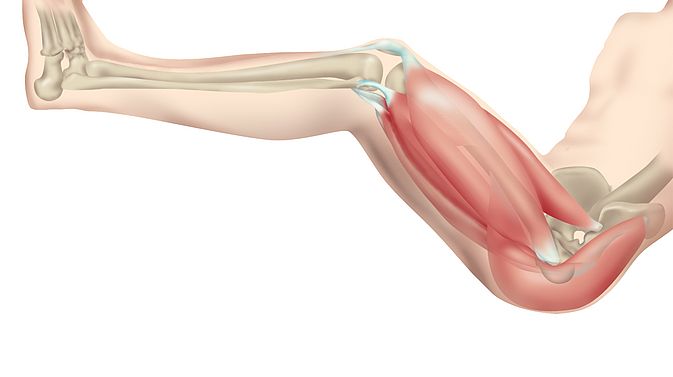
Usage
Exercise
The B6 is a compound exercise which helps to stabilise the lower body.
Leg pressing involves you training the biceps femoris muscle and the quads as well as the semitendinosus, semimembranosus and large gluteal muscles. In this exercise, you use both legs to press the foot board forwards.
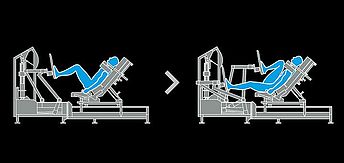
i-B6
Leg press
i-B6
Leg press
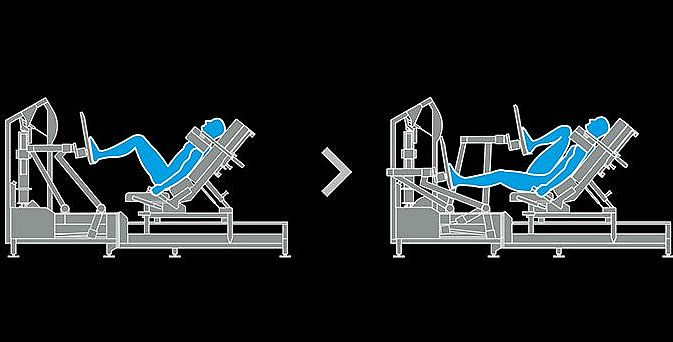

Usage
Exercise
The i-B6 is a compound exercise which helps to stabilise the lower body.
Leg pressing involves you training the biceps femoris muscle and the quads as well as the semitendinosus, semimembranosus and large gluteal muscles. In this exercise, you use both legs to press the foot board forwards.
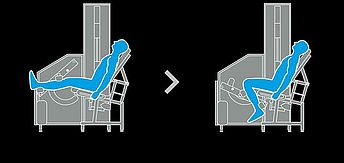
B7
Seated leg curl
B7
Seated leg curl
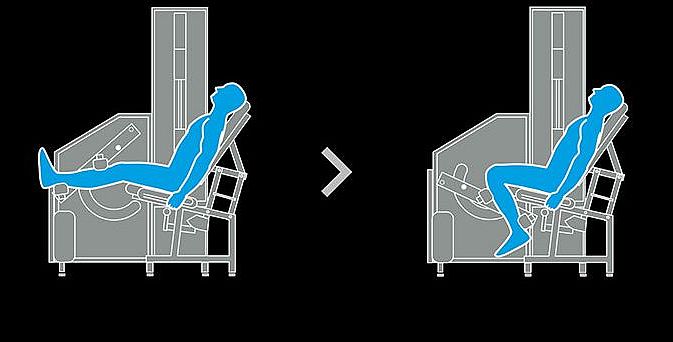

Usage
Exercise
The hamstring muscles play an important role in a number of activities such as walking, running and jumping.
Bending the knee joint in a seated position involves you training the same muscles as with the B5, only in a different position. This trains the biceps femoris, semitendinosus and semimembranosus muscles. In a seated position, you bend the legs at the knee joint by trying to move the heels towards the buttocks as far as possible.
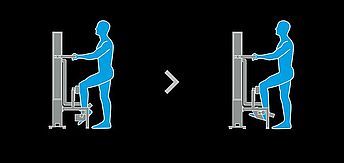
B8
Tibia dorsiflexion
B8
Tibia dorsiflexion
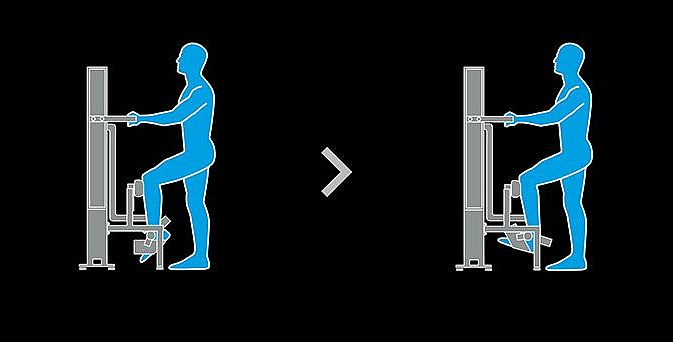
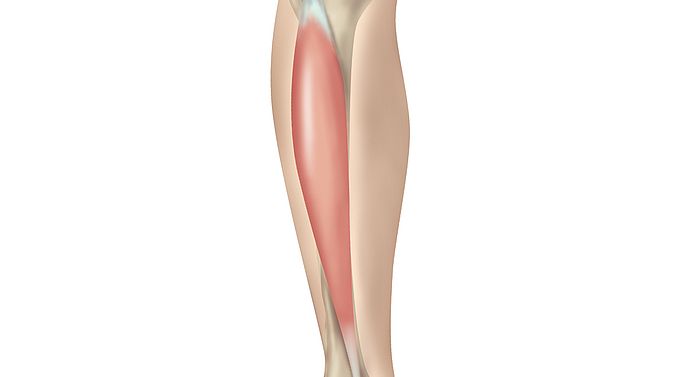
Usage
Exercise
The tibialis anterior muscle is responsible for lifting our feet when we walk and kick.
The tibia dorsiflexion involves you training the tibialis anterior muscle. In this exercise, you lift the foot slowly at the ankle.
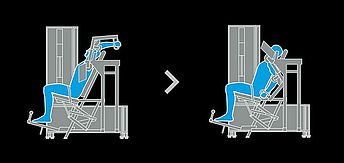
C1
Pullover
C1
Pullover
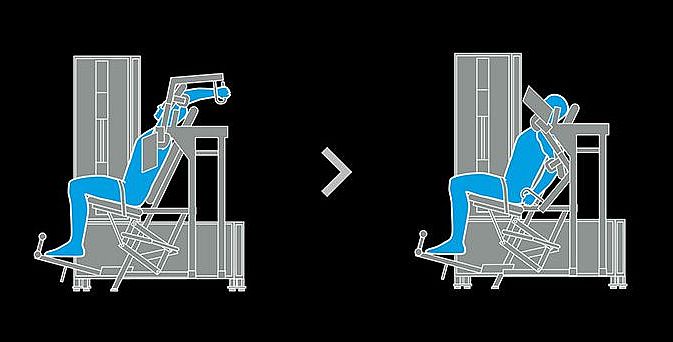

Usage
Exercise
The latissimus dorsi muscle is the muscle most responsible for a healthy shoulder.
Pullovers involve you training the latissimus dorsi muscle. In this exercise, you first push forwards with the upper arms, then down, and finally back as far as you can.
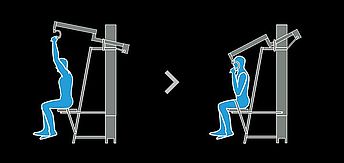
C2
Torso arm front
C2
Torso arm front
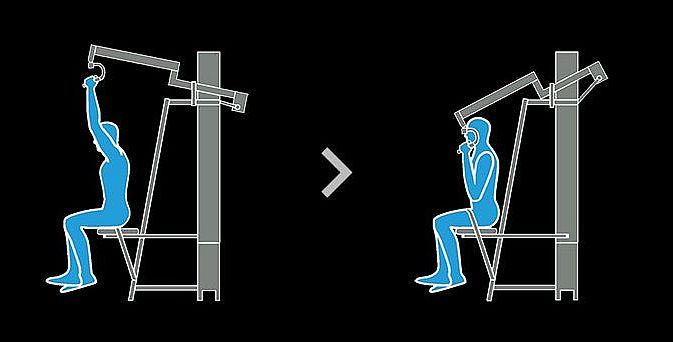
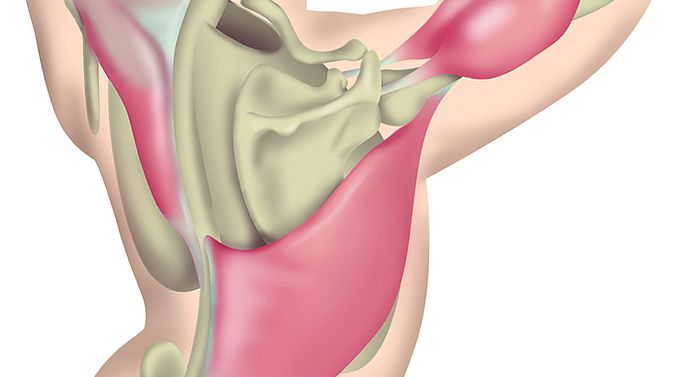
Usage
Exercise
Strengthening the upper back muscles can help to reduce back pain.
The torso arm front involves you training the biceps brachii, trapezius and latissimus dorsi muscles. In this exercise, you pull the handles downwards to the chest.
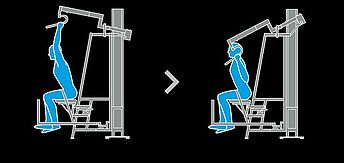
C3
Torso arm
C3
Torso arm
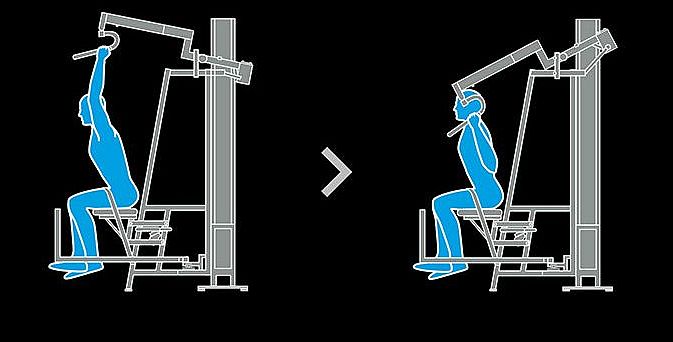
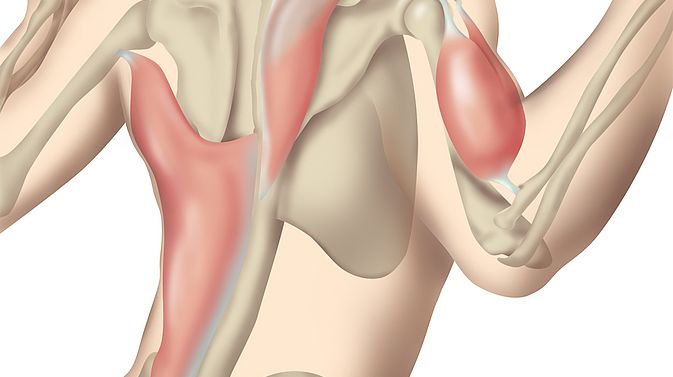
Usage
Exercise
The C3 exercise is suitable to all levels of strength and can help improve posture and reduce shoulder pain.
The torso arm involves you training the same muscles as the torso arm front. This trains the biceps brachii, latissimus dorsi and trapezius muscles. In this exercise, you pull the handles down until you hands are next to your shoulders.
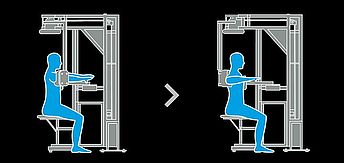
C5
Rowing torso
C5
Rowing torso
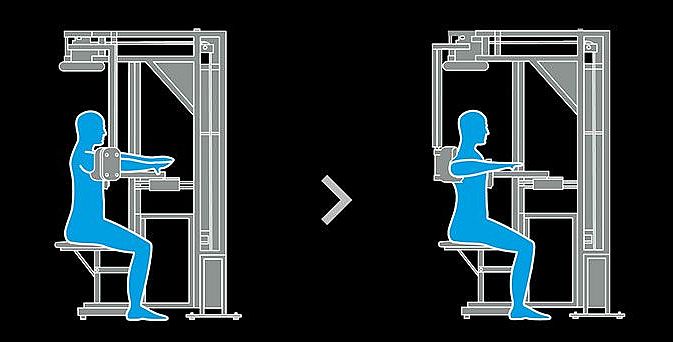

Usage
Exercise
The deltoid muscle helps to carry heavy loads.
The rowing torso exercise involves you training the deltoid, trapezius and rhomboid muscles. In this exercise, you use the arms to push a pad backwards as far as possible, parallel to the ground.
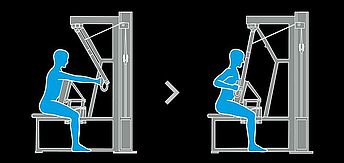
C7
Row
C7
Row
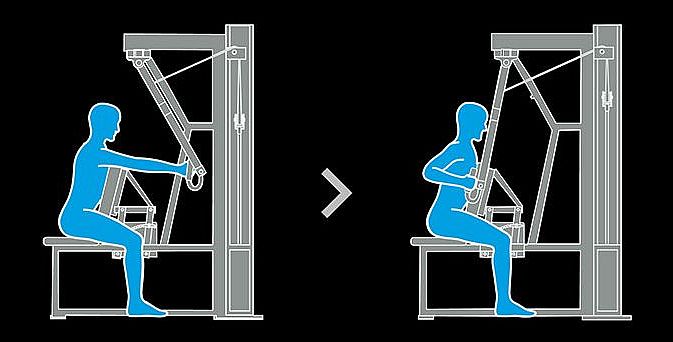
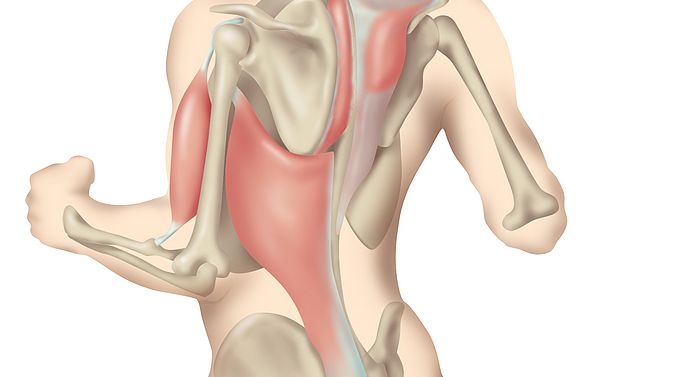
Usage
Exercise
The C7 exercise strengthens the muscles of the upper back which can help to reduce back pain.
The row pull involves you training the latissimus dorsi, biceps brachii, trapezoid and rhomboid muscles. In this exercise, you pull the handles back, moving the elbows closely past the body.
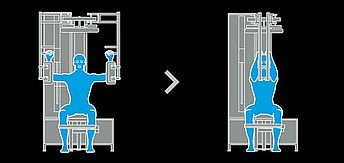
D5
Arm cross
D5
Arm cross
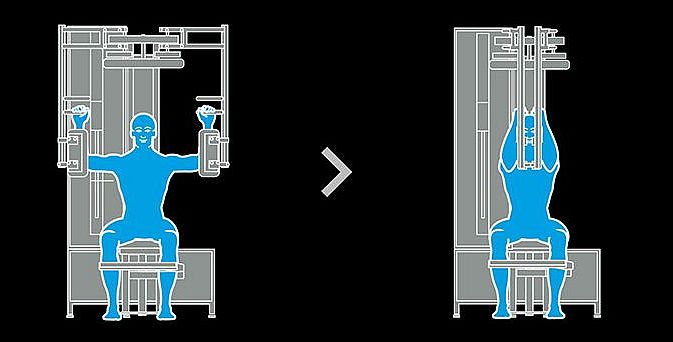
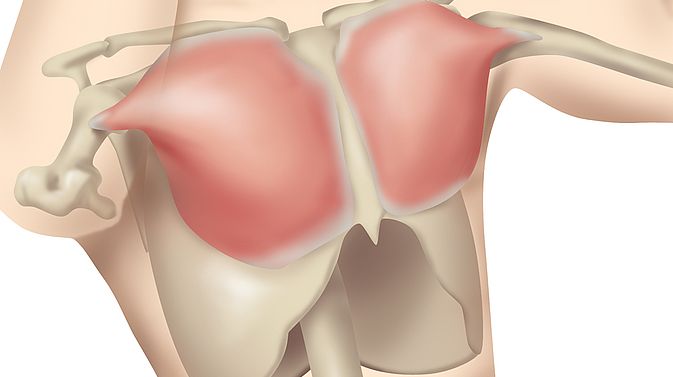
Usage
Exercise
The pectoralis major muscle helps to define the anterior axilliary fold.
The arm cross exercise trains the pectoralis major muscle. In this exercise, the upper arms are parallel with the ground, and you push the levers forwards until they touch.
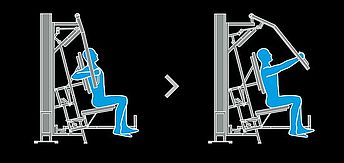
D6
Chest press
D6
Chest press
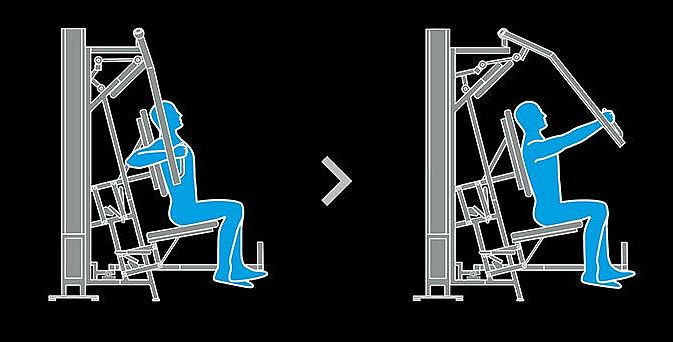
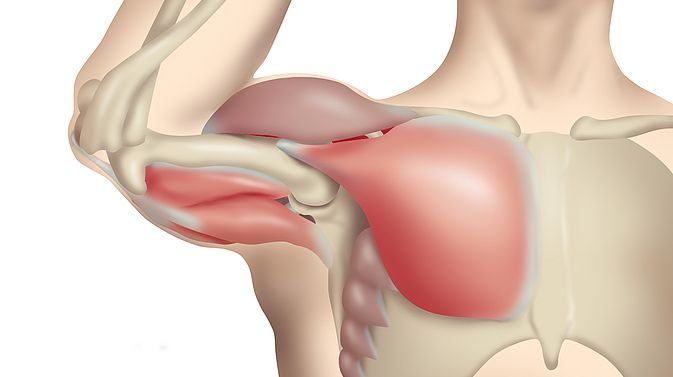
Usage
Exercise
The pectoralis major muscle is responsible for enabling the upper arm to rotate inwards in the shoulder.
The chest press involves you training the pectoralis major and triceps brachii muscles. In this exercise, you push the levers forwards without stretching your arms entirely.
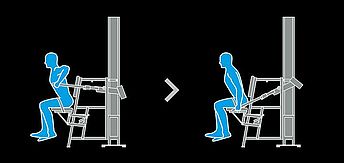
D7
Seated dip
D7
Seated dip
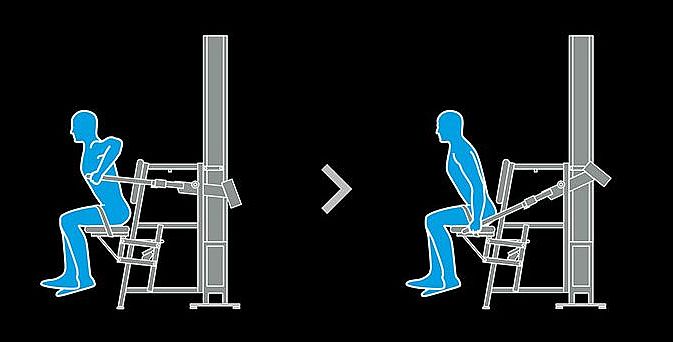

Usage
Exercise
The triceps are responsible for stretching the arm at the elbow joint.
During the seated dip exercise, you train the pectoralis major, triceps brachii and trapezoid muscles. In this exercise, you pull the handles down while keeping the elbows pointed outwards.
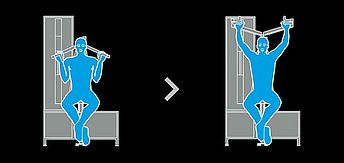
E1
Neck press
E1
Neck press
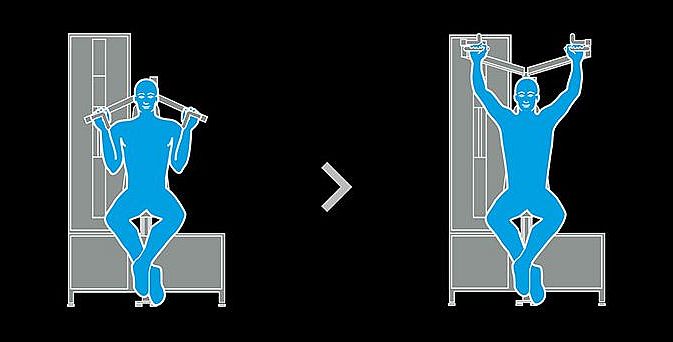

Usage
Exercise
The deltoid muscles help to stabilise the shoulders.
The neck press involves you training the deltoid muscle, the triceps brachii and serratus anterior muscles. In this exercise, you push the handles upwards without stretching the elbows entirely.
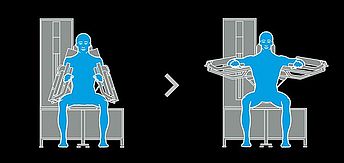
E2
Lateral raise
E2
Lateral raise
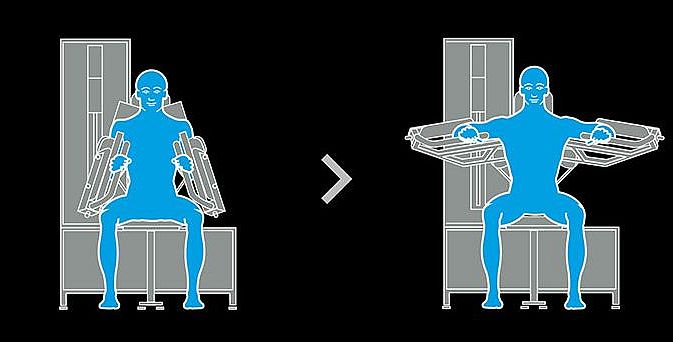
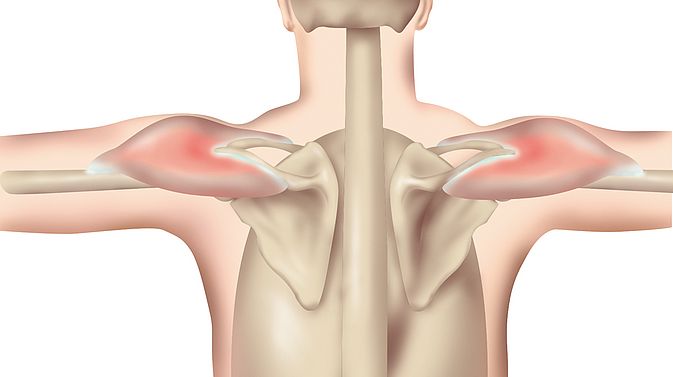
Usage
Exercise
The E2 exercise helps in a number of activities such as lifting things from the ground, opening jars or brushing your hair.
Lateral raises involve you training the deltoid muscle. In this exercise, the upper arm is perpendicular to the lower arm. Using the elbow, you push the cushion upwards and to the side.
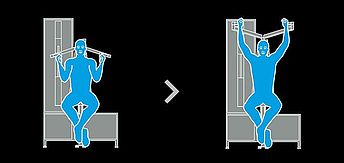
E3
Overhead press
E3
Overhead press
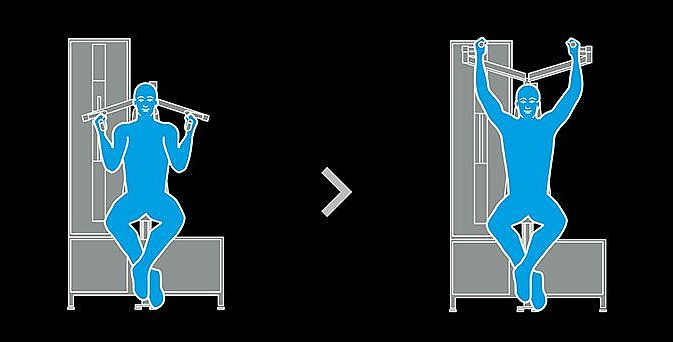
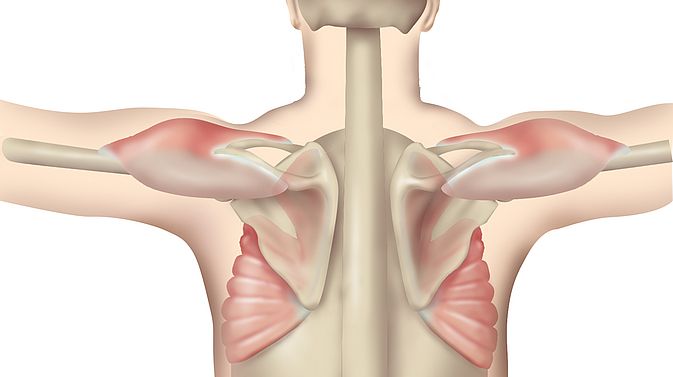
Usage
Exercise
The overhead press strengthens the main muscles of the shoulder and thus is a great exercise to help prevent shoulder injury.
Pressing involves you training the deltoid, triceps brachii, pectoralis major and serratus anterior muscles. In this exercise, you push the handles upwards without stretching the elbows entirely.
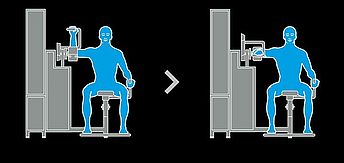
E4
Internal rotation of shoulder
E4
Internal rotation of shoulder
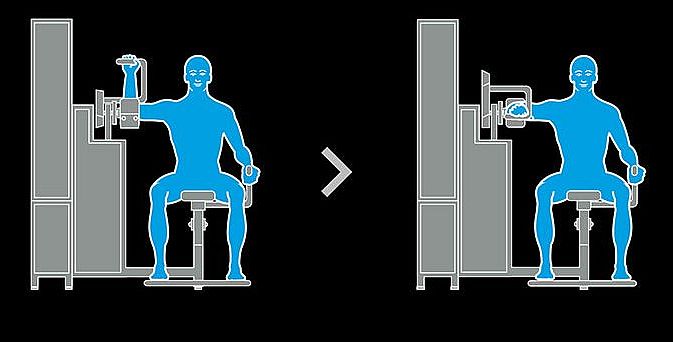

Usage
Exercise
The subscapularis muscle locks the shoulder joint in place during rotation.
The inward shoulder twist involves you training the subscapularis muscle. In this exercise, you twist the arm forwards and downwards.
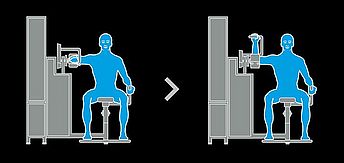
E5
External rotation of shoulder
E5
External rotation of shoulder
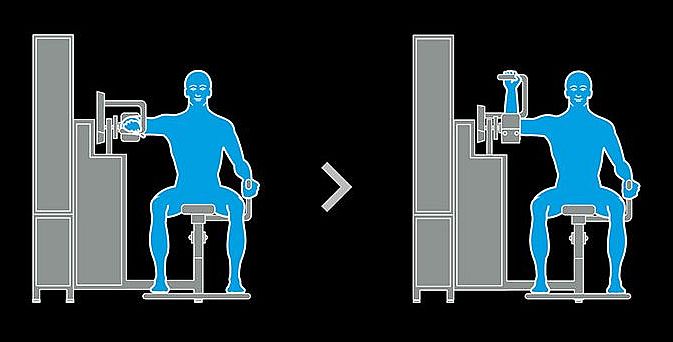
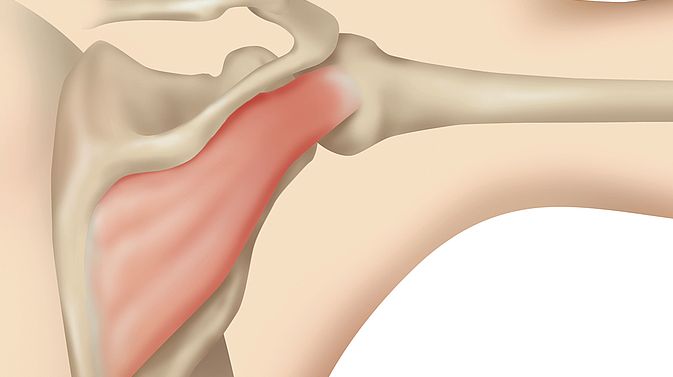
Usage
Exercise
The infraspinatus muscle is responsible for performing a strong outwards rotation.
The external rotation of shoulder involves you training the infraspinatus muscle. In this exercise, you twist the arm upwards and backwards.
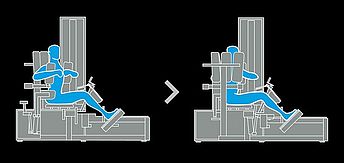
F1.1
Rotary torso
F1.1
Rotary torso
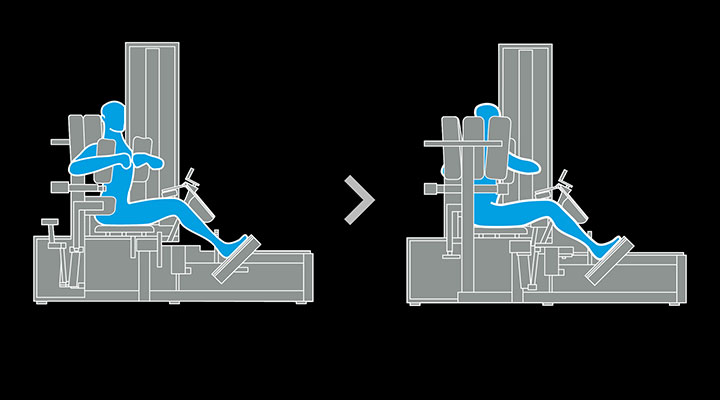
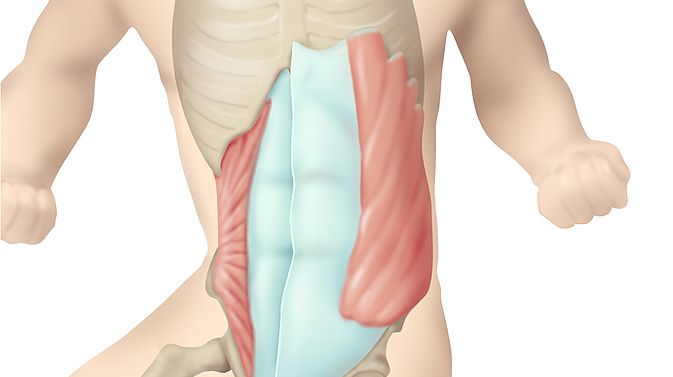
Usage
Exercise
The abdominal oblique muscles are able to twist the torso without causing the pelvis to twist with it.
A rotary torso involves you training the internal and external oblique muscles. In this exercise, you turn the torso to the left and to the right.
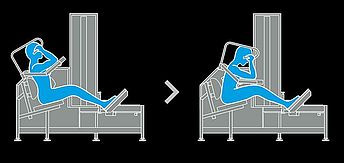
F2.1
Abdominal
F2.1
Abdominal
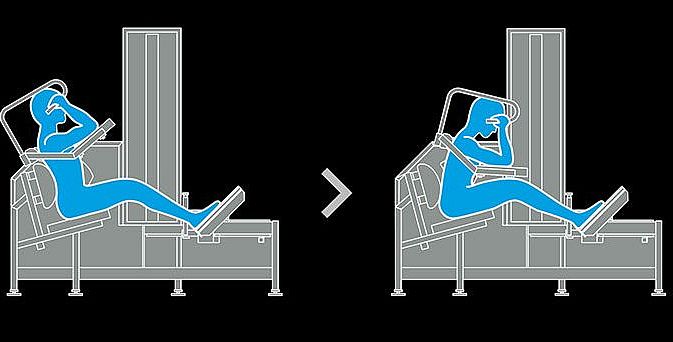
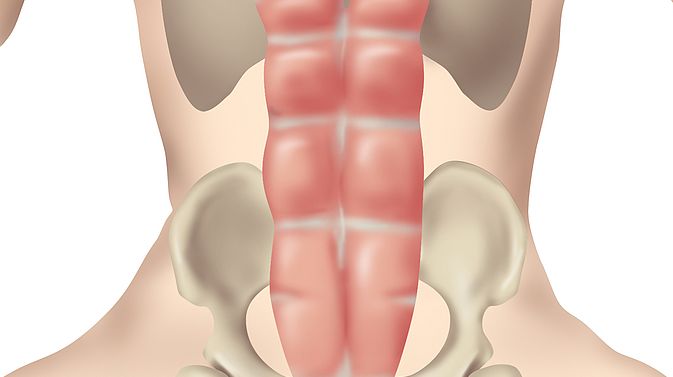
Usage
Exercise
The straight muscles of the abdomen stabilise the position of the pelvis and thus can reduce the strain on the lumbar discs.
The abdominal exercise involves you training the rectus abdominis muscle. In this exercise, you curl up your body.
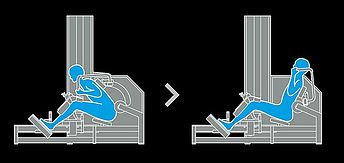
F3.1
Lower back
F3.1
Lower back
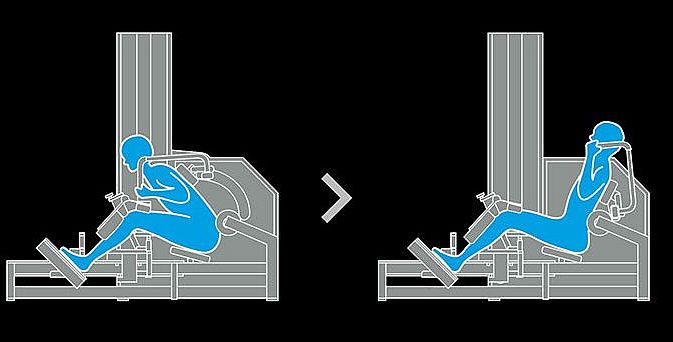
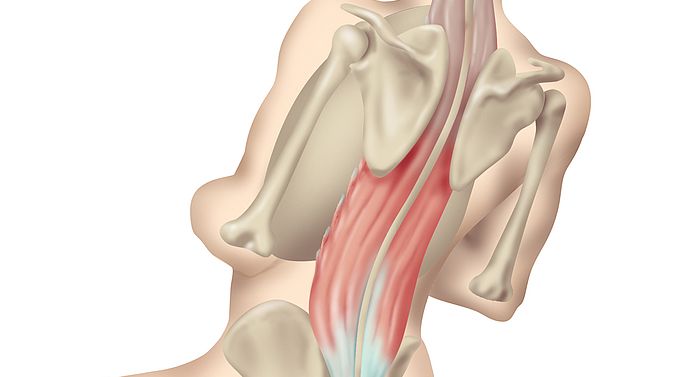
Usage
Exercise
The spinal erectors are responsible for supporting the spine and defining your posture.
The lower back exercise involves you training the spinal erectors, which are the spine’s stretching muscles. In this exercise, you sit up straight, then stretch back as far as possible.
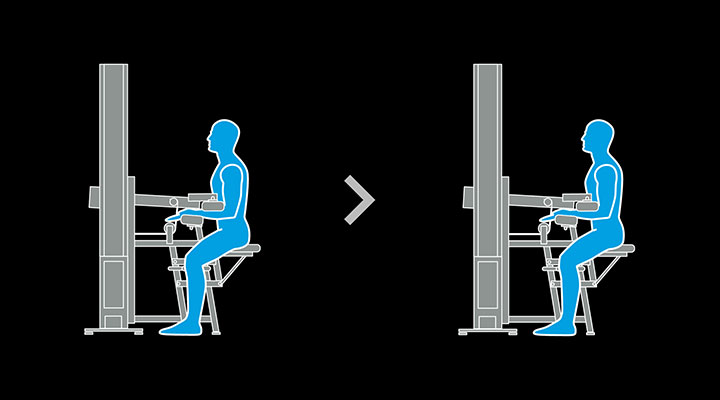
G1
Neck and shoulder
G1
Neck and shoulder
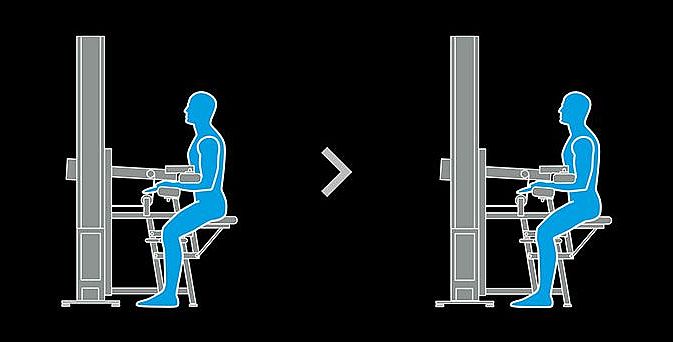
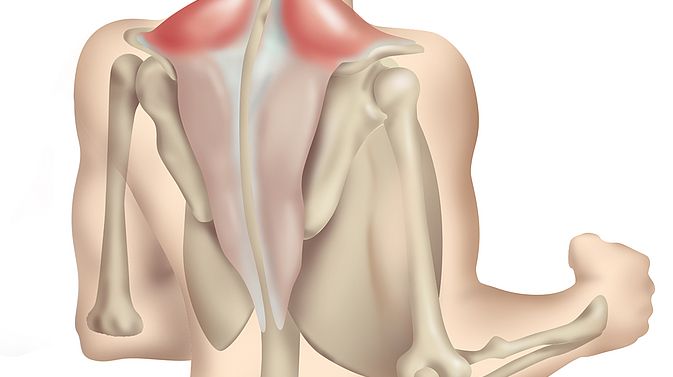
Usage
Exercise
A trained trapezoid muscle can help to relieve pain and tension in the shoulder.
The neck and shoulder exercise involves you training the trapezoid muscle. In this exercise, you lift the shoulders up as far as possible.
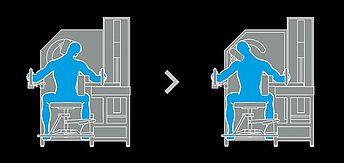
G3
4-way neck - side
G3
4-way neck - side
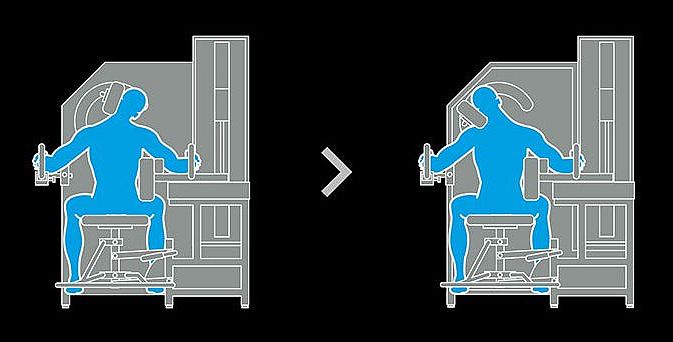
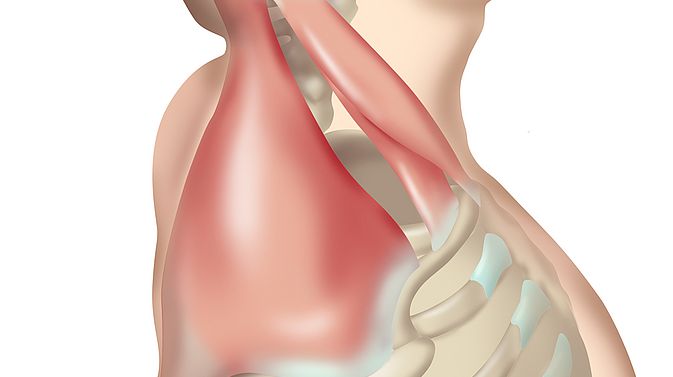
Usage
Exercise
The G3 exercise can help to reduce pain in the head and neck.
The 4-way neck - side exercise involves you training the sternocleidomastoideus and trapezoid muscles. In this exercise, you move your head towards the pad and push it to the side.
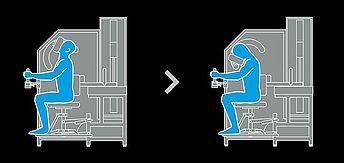
G4
4-way neck - front
G4
4-way neck - front
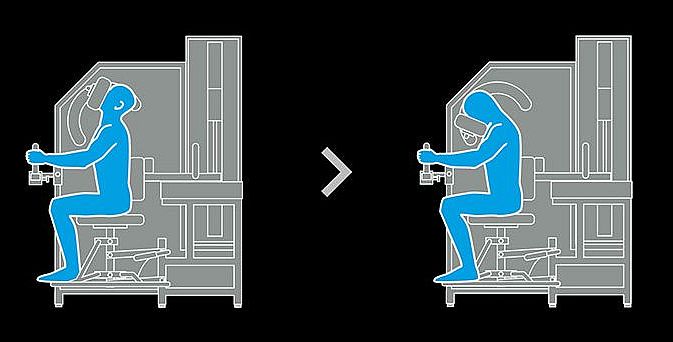
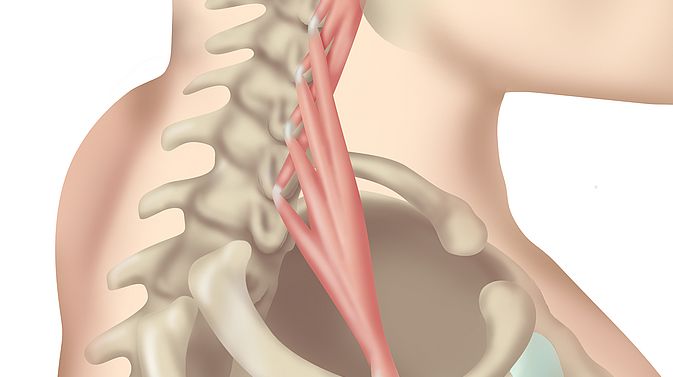
Usage
Exercise
The scalene muscles lift the first rib when inhaling.
The 4-way neck - front exercise involves you training the longus capitis muscle and the scalene muscle. In this exercise, you place your head in the head pad and push it slowly forwards.
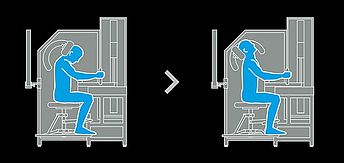
G5
4-way neck - rear
G5
4-way neck - rear
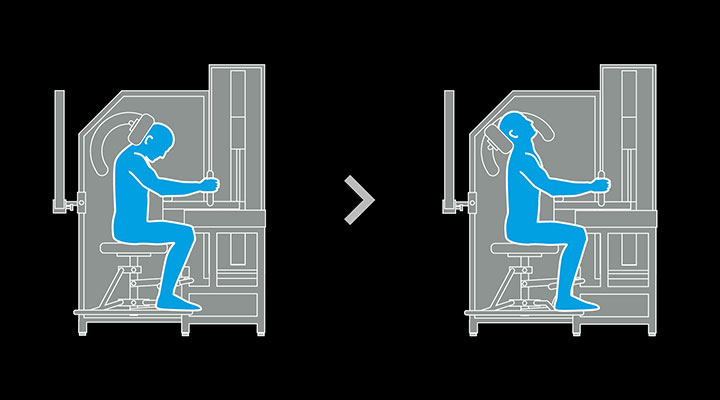
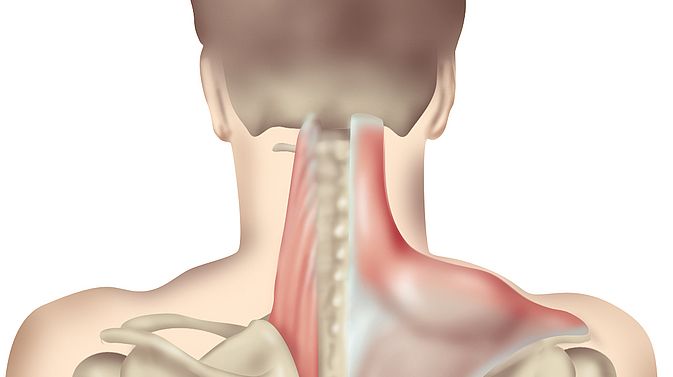
Usage
Exercise
Strengthening the neck muscles can help reduce chronic neck pain.
The 4-way neck - rear exercise involves training the spinal extensors and the trapezoid muscle. In this exercise, you place the back of your head in the pad and push it slowly backwards.
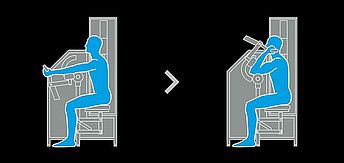
H1
Biceps
H1
Biceps
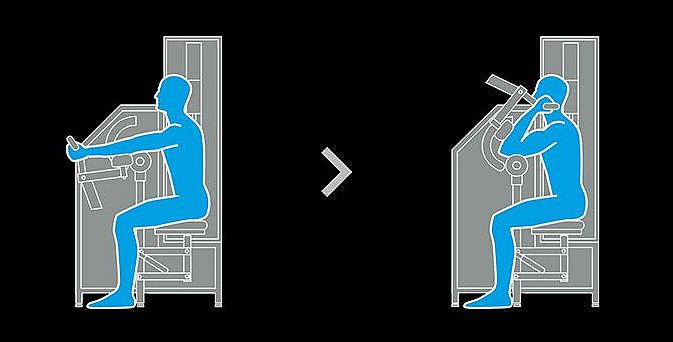
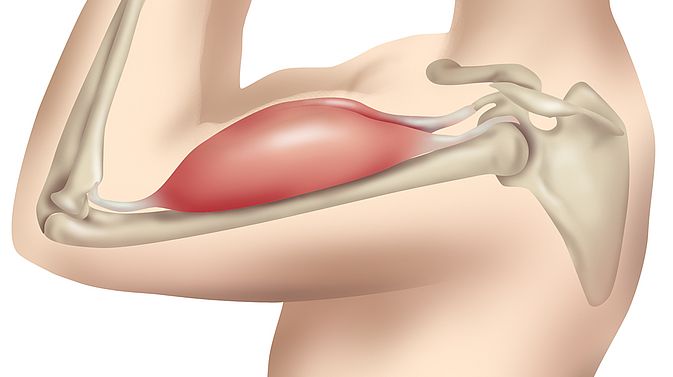
Usage
Exercise
The H1 flexes your arm at the elbow joint which is an action you perform countless times each day.
The biceps exercise involves you training the biceps brachii muscle. In this exercise, the elbows are positioned between the pads and you move the arms as far as possible.
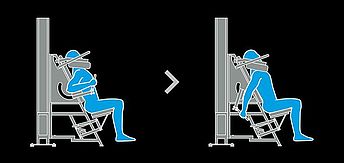
H2
Triceps
H2
Triceps
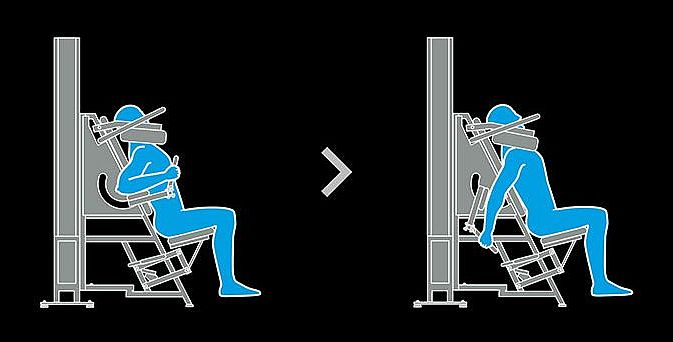
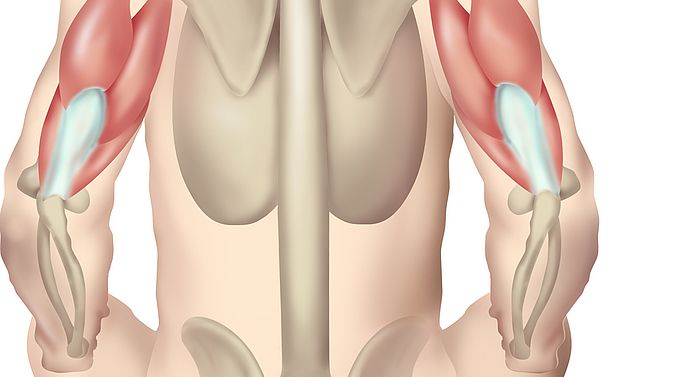
Usage
Exercise
The tricep muscles help in a number of daily activities such as lifting yourself out of bed in the morning.
The triceps exercise involves you training the triceps brachii muscle. In this exercise, you stretch the arms as far back as possible.

H3
Wrist pronation
H3
Wrist pronation

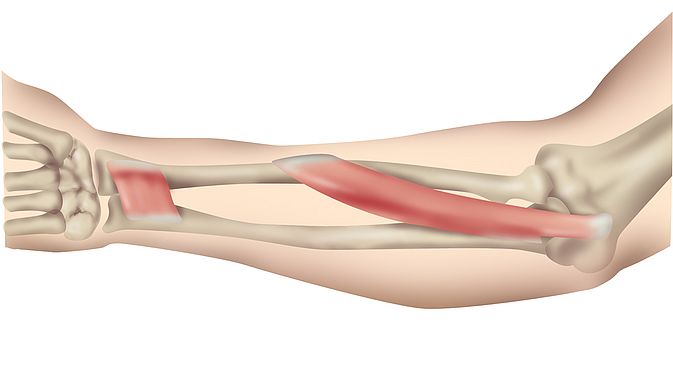
Usage
Exercise
The pronator muscle is used to move the bone of the lower arm into pronation position and is a weak flexor in the elbow joint.
Wrist pronation involves you training the pronator muscle. In this exercise, you stretch your fists as far inwards as possible.
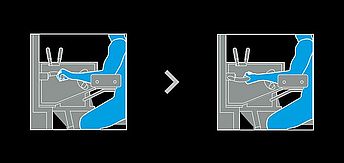
H4
Wrist supination
H4
Wrist supination
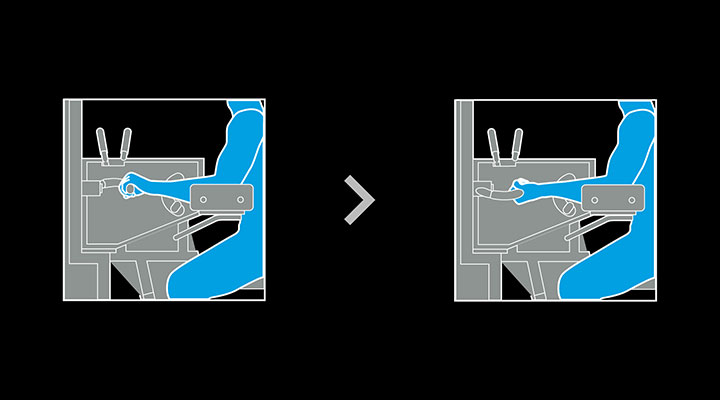

Usage
Exercise
The supinator is the most important muscle for outward rotation with low force.
Wrist pronation involves you training the biceps brachii and supinator muscles. In this exercise, you rotate your hands outwards as far as possible.
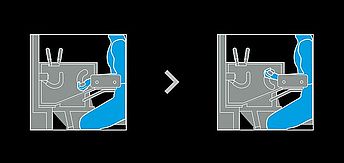
H5
Wrist curl
H5
Wrist curl
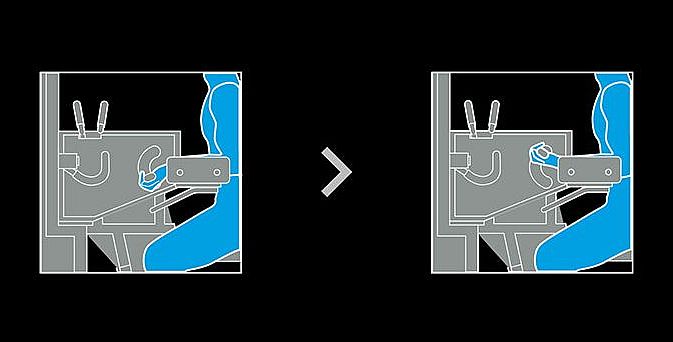
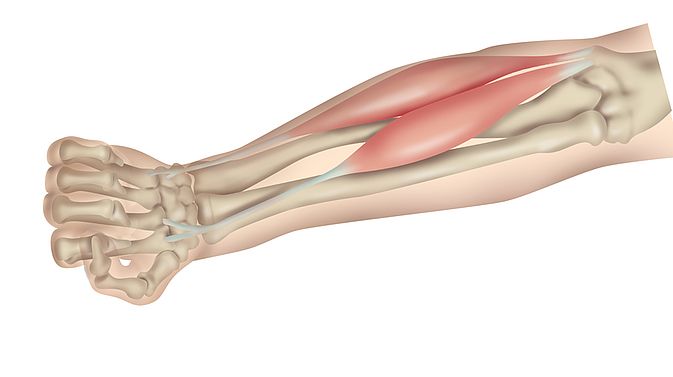
Usage
Exercise
The flexor carpi muscles lock the hand in place when the extensor digitorum longus muscles are active.
The wrist curl exercise involves training the flexor carpi muscles. In this exercise, you bend your hands outwards in the wrists as far as possible.
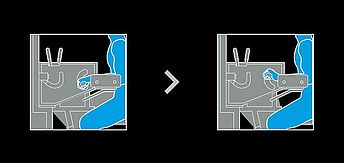
H6
Reverse wrist curl
H6
Reverse wrist curl
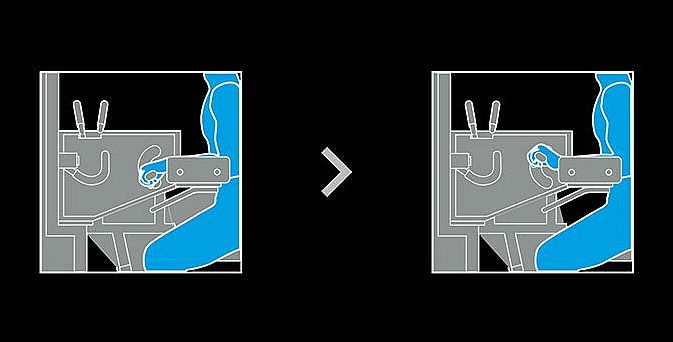
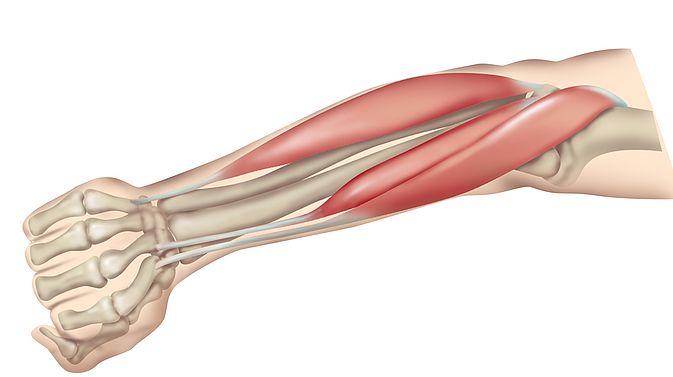
Usage
Exercise
The extensor muscles of the hand prevent the wrist from flexing while the fingers are strongly flexed.
The reverse wrist curl exercise involves training the extensor carpi muscles. In this exercise, you stretch your hands upwards in the wrists as far as possible.
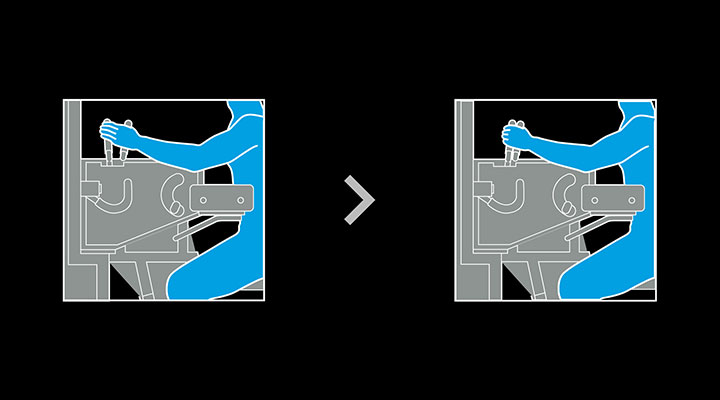
H7
Hand grip
H7
Hand grip
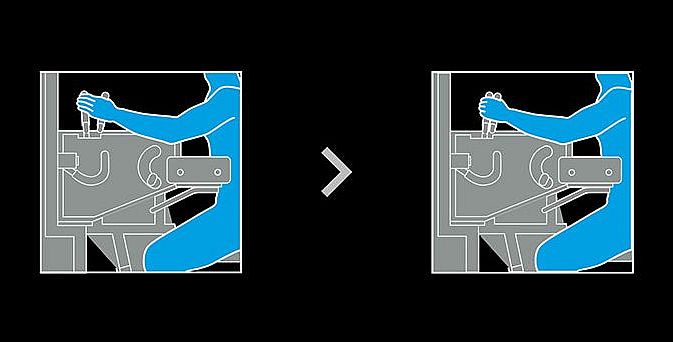
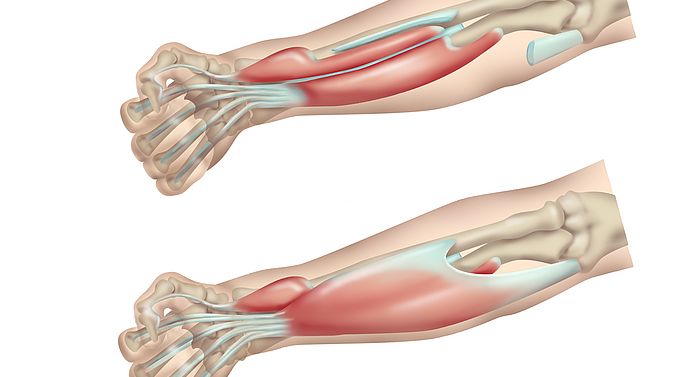
Usage
Exercise
The flexor digitorum muscles are the only flexor muscles in the end joints of the fingers and helps to improve your grip.
The hand grip exercise involves you training the flexor digitorum muscles. In this exercise, you grab the rear moving handles and move these up to the fixed front handles so that you can place your thumbs around the handles.
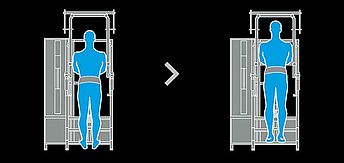
J1
Calf raise
J1
Calf raise
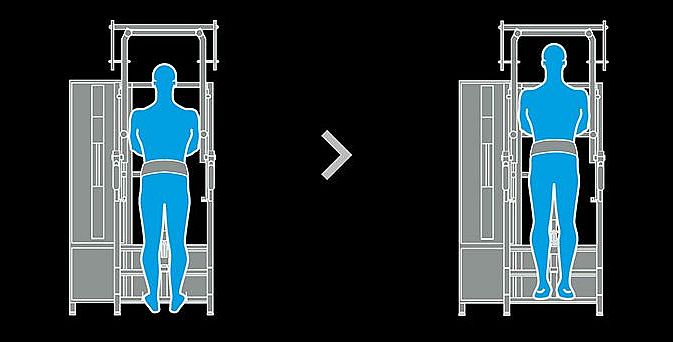
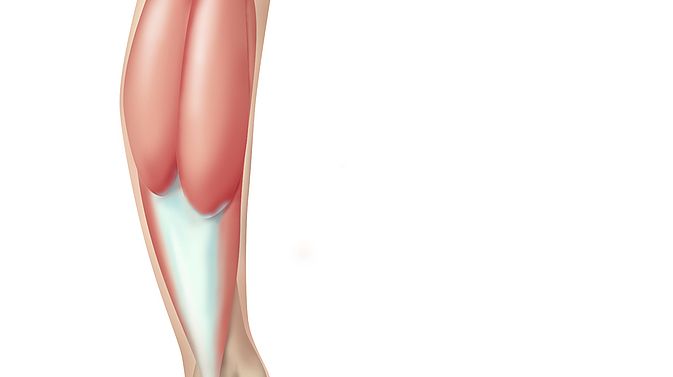
Usage
Exercise
Strengthening the gastrocnemius muscle helps you to jump higher or rehabilitate your Achilles Tendon.
The calf raise involves the training of the gastrocnemius and soleus muscles. In this exercise, you lift the heel until you are standing on your toes.
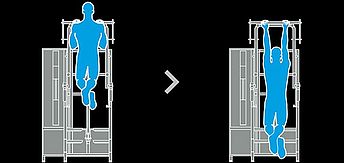
J2
Front chin
J2
Front chin
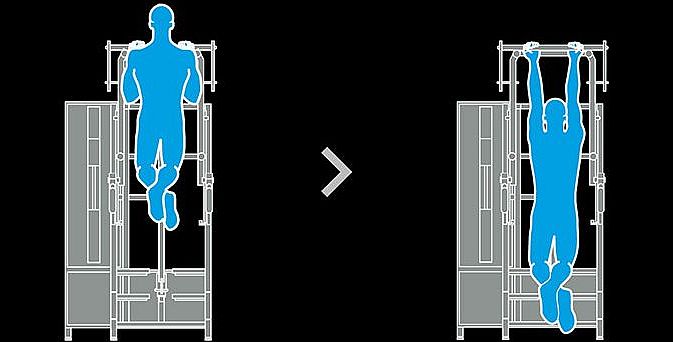
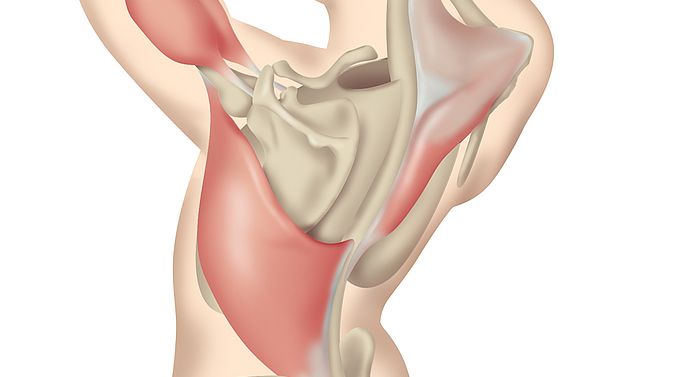
Usage
Exercise
The trapezoid muscle connects the shoulder blades to the spine.
The front chin involves you training the latissimus dorsi, trapezoid and biceps brachii muscles. In this exercise, you grab the bar and gradually lower your body until your arms are stretched.
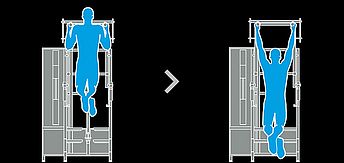
J3
Parallel chin
J3
Parallel chin

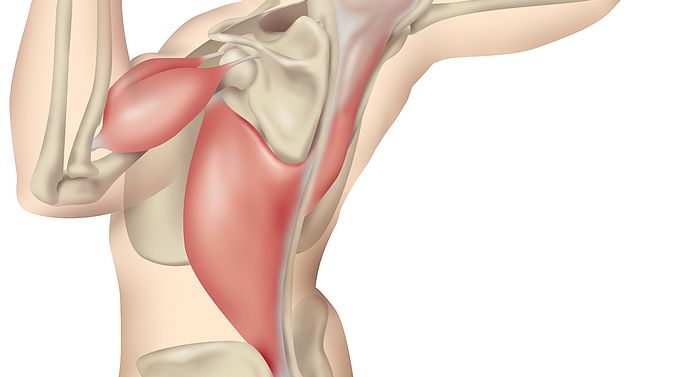
Usage
Exercise
The parallel chin exercise strengthens the upper back muscles to help reduce back pain.
The parallel chin, like the front chin, involves you training the latissimus dorsi, trapezoid and biceps brachii muscles. In this exercise, you grab the side bars and gradually lower your body until your arms are stretched.
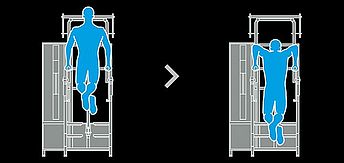
J4
Dips
J4
Dips
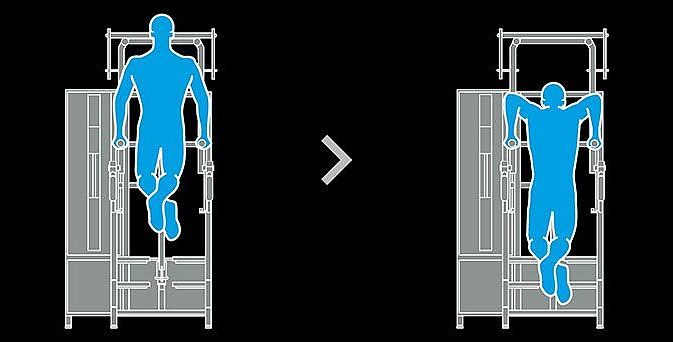
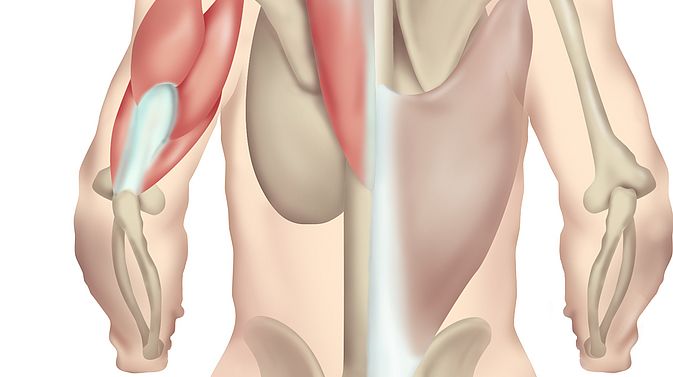
Usage
Exercise
The dips exercise is a compound exercise which helps to strengthen the chest, arms and upper back.
Dips involves you training the pectoralis major, trapezoid and triceps brachii muscles. In this exercise, you support yourself on the lateral handles and lower your body until fully stretched.
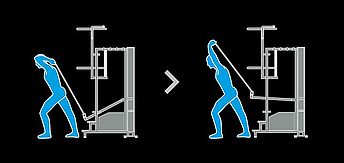
J5
Triceps extension
J5
Triceps extension
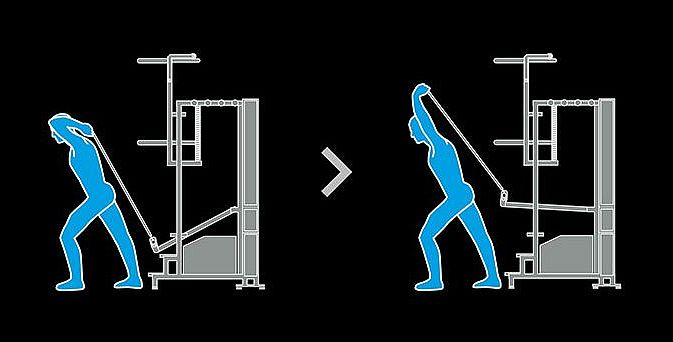
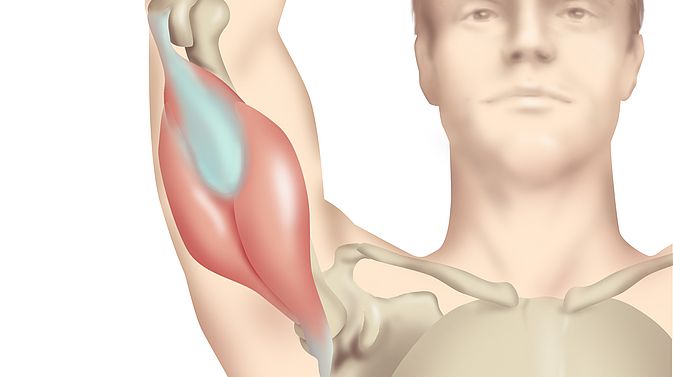
Usage
Exercise
One function of the triceps brachii is to ensure that the arms provide stable support on the handlebars while cycling.
The triceps extension exercise trains the triceps brachii. In this exercise, you grab the rope with both hands and stretch the arms almost as far as they will go.
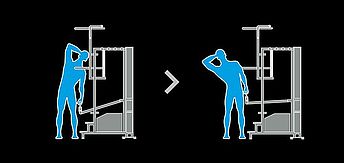
J9
Side bend
J9
Side bend
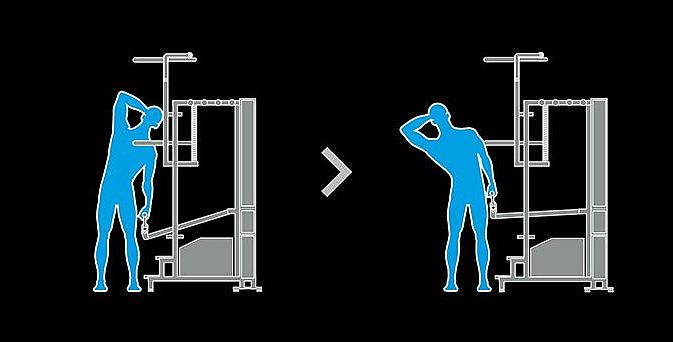
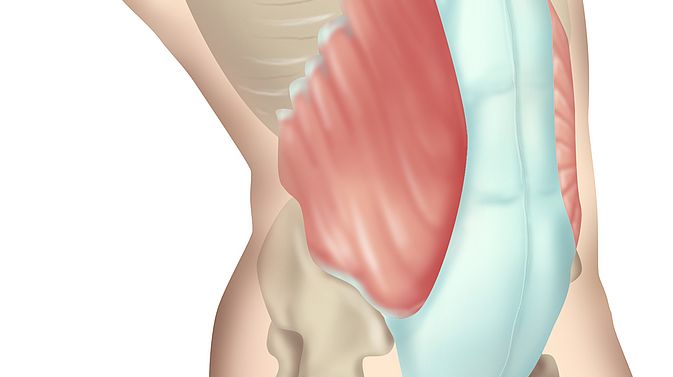
Usage
Exercise
The abdominal oblique muscles help to rotate the trunk and stabilise the core.
The side bend involves training the external and internal abdominal oblique muscles as well as the quadratus lumborum muscle. In this exercise, you hold the handle and flex laterally to the machine back into the starting position. Move your upper body to the other side as soon as you are able.
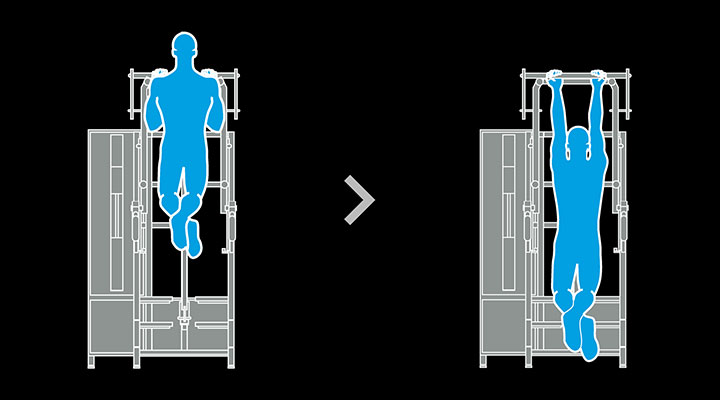
K2
Front chin - supported
K2
Front chin - supported


Usage
Exercise
The trapezoid muscle connects the shoulder blades to the spine.
The front chin - supported involves you training the latissimus dorsi, trapezoid and biceps brachii muscles. In this exercise, you hold the bar and pull your body upwards until your chin reaches the bar’s height.
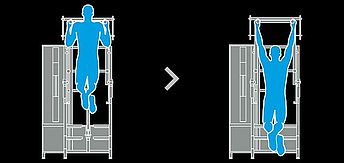
K3
Parallel chin - supported
K3
Parallel chin - supported
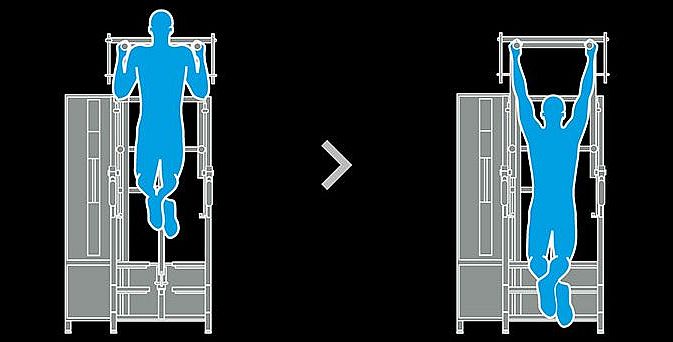

Usage
Exercise
The parallel chin - supported exercise strengthens the upper back muscles to help reduce back pain.
The parallel chin - supported, like the conventional parallel chin, involves you training the latissimus dorsi, trapezoid and biceps brachii muscles. In this exercise, you hold the lateral bars and pull your body upwards until your chin reaches the bar’s height.
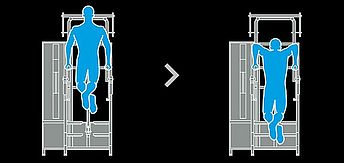
K4
Dips - supported
K4
Dips - supported
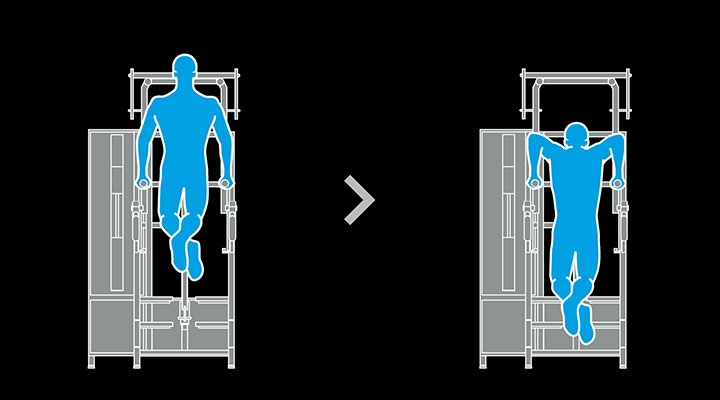

Usage
Exercise
The dips - supported exercise is a compound exercise which helps to strengthen the chest, arms and upper back.
Dips - supported involves you training the pectoralis major, trapezoid and triceps brachii muscles. In this exercise, you support yourself on the lateral handles and lower your body until fully stretched.
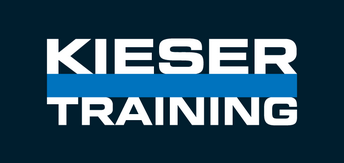
LE
Lumbar Extension Machine
LE
Lumbar Extension Machine
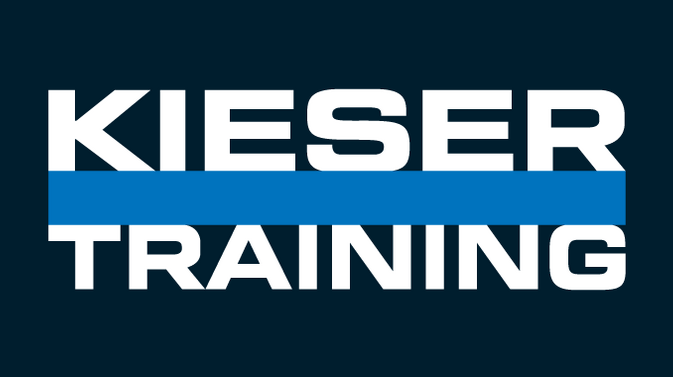

Usage
Exercise
The LE strengthens the extensor muscles of the spine in order to reduce and prevent lower back pain.
The lumbar extension (LE) trains the extensors and postural muscles of the lumbar spine down to the lower thoracic spine.

CE
Cervical Extension Machine
CE
Cervical Extension Machine


Usage
Exercise
Strong neck muscles are key in improving chronic neck pain.
Cervical extension (CE) trains the extensors and postural muscles of the cervical spine down to the upper thoracic spine. This exercise will be supervised by a Physiotherapist and involves your upper body being restrained. You place the back of your head in the cushion and move it back and forth slowly.